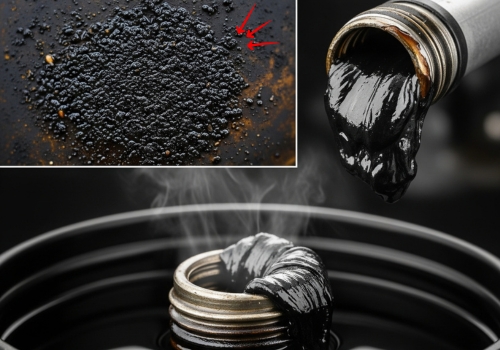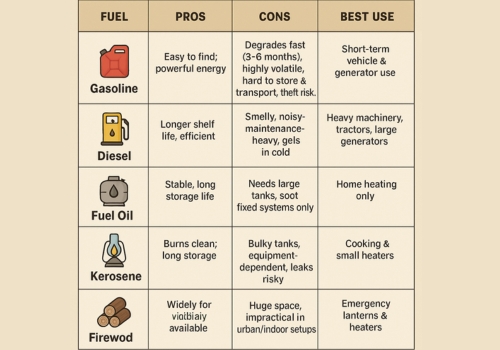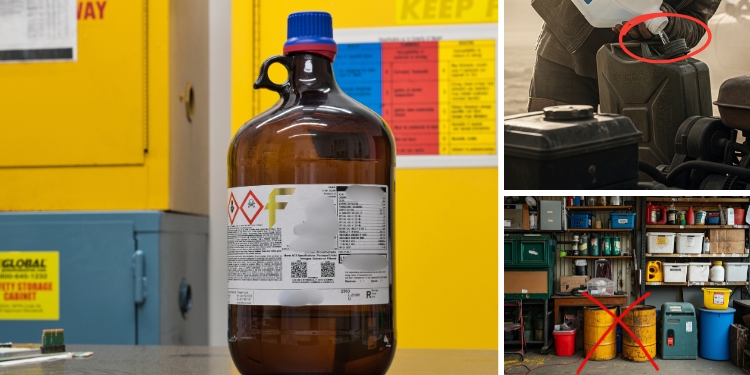When it comes to prepping, everyone’s got strong opinions on the best fuel source to stockpile for the long haul. Gasoline, diesel, propane, and even good old firewood all take the spotlight when it comes to short-term survival fuels.
Yet each has its own set of crippling drawbacks that can throw a wrench into your long-term survival plan. After years of testing, failing, and learning the hard way, I’ve narrowed down my choice to a surprising but rock-solid solution: isopropyl alcohol. It’s the one I trust the most for versatility, safety, and longevity. Here’s why.
The Problem with Traditional Fuels
Traditional fuels like gasoline, diesel, and propane all have limitations that only get worse as time drags on. While they might get you by in a short-term crisis, they can become an expensive liability in a long-term stockpile.
Gasoline Is Highly Volatile and Difficult to Store
Gasoline might be the go-to for powering generators and vehicles, but it degrades quickly. Without a stabilizing agent, gasoline can separate and degrade in as little as three to six months.
It also requires pressurized, fireproof storage – especially if you’re riding out winter in cold weather. Not to mention it’s prone to dangerous vapor buildup.
Gasoline is nearly impossible to store discreetly or transport without serious risks. This makes it an appealing target for would-be thieves and even neighbors who need gas for their generators, vehicles, and equipment in the early days of a crisis.
Diesel Is Better Suited for Other Things
When it comes to stockpiling fuels, diesel is often praised for its longer shelf life compared to gasoline, especially with a good stabilizer mix.
Yet diesel fuel isn’t without issues. It’s thick, smelly, and leaves behind soot and residue when burned. This alone makes it poorly suited for indoor or small-space use.
Diesel engines and generators tend to be loud, bulky, and require ongoing maintenance. All that noise can draw in curious eyes and ears you don’t want around. If you have a homestead or retreat location as your long-term survival destination, every drop of diesel fuel needs to be saved for tractors, machinery, or big generators.
In cold weather, diesel can gel and become unusable without additives. In deep cold, diesel can gel into a waxy sludge, clogging fuel lines and rendering engines useless unless treated with anti-gel additives.

Fuel Oil Is Stable but Only Practical for Home Heating
These days, fuel oil is only really used in home heating systems. It’s relatively stable and can be stored for years with the right treatment.
Yet it requires large, stationary tanks and specialized furnaces or burners that aren’t portable or easily repaired. Fuel oil also produces heavy soot and emissions when burned, making it unsuitable for indoor cooking or small-space heating.
If you already have a fuel oil furnace installed in your home, it’s fine to top up the tank and stockpile a secondary tank. Then use the furnace sparingly to get through the first winter. Otherwise, it really doesn’t have any other long-term stockpile value.
👉 How to Build the Oven That Cooks Without Fire, Fuel, Smell, or Smoke
Propane Is Bulky & Equipment-Dependent
As a stockpile fuel, Propane burns clean and stores longer than gasoline, but the tanks are cumbersome. You’re also reliant on equipment like stoves or heaters that are compatible with propane regulators. If any part of that system fails, or a tank leaks, you’re left with a large metal container and no fire.
Kerosene Is Useful But Dirty and Outdated
Kerosene has long been used for lighting and heating in lanterns and space heaters, but it’s far from ideal as a long-term stockpile fuel. While it stores better than gasoline, it still degrades over time and can attract moisture and even mold if not kept airtight. It burns with a strong odor and produces soot, which can cause indoor air quality issues and leave residue on walls and ceilings.
Kerosene appliances are bulky, outdated, and increasingly hard to find or replace parts for. Storing large amounts of kerosene safely is a fire risk and requires metal containers that are expensive and cumbersome.
Firewood Space Hog & Not Always Practical
While it’s the oldest fuel known to man, firewood takes up massive amounts of space and is only practical in specific environments. Wet climates, apartment settings, and other urban bug-in locations make it difficult to store and use firewood.

Is Isopropyl Alcohol the Same as Rubbing Alcohol?
Now moving on to my favourite fuel. Many folks wonder: is isopropyl alcohol the same as rubbing alcohol? The short answer is no, although they’re closely related. Isopropyl alcohol (IPA) is the pure chemical compound, usually sold in high concentrations like 70% or 99%. It’s a strong disinfectant and evaporates quickly.
On the other hand, rubbing alcohol is a diluted solution, generally around 70% isopropyl or sometimes ethyl alcohol mixed with water and other additives like denaturants or fragrances. These additives make it safer for skin use and help prevent misuse.
Why Isopropyl Alcohol Is a Great Stockpile Fuel
Its versatility, stability, and ease of storage are just some of the reasons why I like isopropyl alcohol (IPA) as a long-term stockpile fuel.
Available in Different Concentrations
The most common types are 70% and 91% isopropyl alcohol. The 91% burns more efficiently, making it ideal for fuel use. The 70% variety is better for sanitizing skin but still works as a burner in a pinch. If you find 99% or anhydrous forms, consider that a prepper’s jackpot.
Versatility
Isopropyl alcohol isn’t just for first aid. It’s an excellent multi-purpose fuel that burns clean, hot, and nearly smokeless when used properly. You can cook with it, sterilize tools, clean surfaces, and start campfires. You can even power certain alcohol stoves or improvise homemade tuna can burners.
Just like these 4 essential antibiotics that people stockpile, isopropyl alcohol can be used for medical purposes, especially in emergency or survival situations. It is commonly applied to disinfect the skin before injections, clean small cuts or scrapes, and sanitize medical tools or surfaces.
However, it should never be used on deep wounds, large burns, or ingested internally, as it can irritate tissues and delay healing. For effective disinfection, a 70% concentration is recommended since higher concentrations evaporate too quickly.
Easy to Store and Transport
Unlike propane or gasoline, isopropyl alcohol doesn’t require special pressurized containers. A few gallons can be tucked away on shelves, under beds, or in your bug-out bag without taking up much room or raising eyebrows.
Does Isopropyl Alcohol Expire?
When kept sealed and stored in a cool, dark place, isopropyl alcohol can last indefinitely. While some manufacturers list an expiration date of 2–3 years, this is mainly due to FDA labeling regulations. In practice, the chemical structure remains stable for many years. Providing it’s not exposed to sunlight.
Safe for Indoor Use with Ventilation
Another great thing about isopropyl alcohol is that it burns without producing deadly carbon monoxide. While you should still ventilate to avoid vapor buildup, it’s much safer to burn in small, enclosed spaces than fossil fuels.
How To Store Isopropyl Alcohol Long-Term
Storage matters when it comes to stockpiling isopropyl alcohol as a long-term fuel source.
Use the Right Containers
Isopropyl alcohol tightly sealed plastic bottles, preferably HDPE (high-density polyethylene), which resist chemical degradation. You can also use glass containers like old mason jars or glass bottles with resealable lids.
Avoid Direct Sunlight
Store isopropyl alcohol containers in a dark cabinet, closet, or in tote bin under the bed. Sunlight can degrade isopropyl alcohol’s carbon chains. The heat of direct sunlight over time can also start to warp plastic storage containers or cause photodegradation-related leaks.
If you want to store isopropyl alcohol in big quantities for the long haul, or if you’re looking to keep other critical supplies safe and ready for when disaster strikes, one bold option is to bury a shipping container right in your backyard. This gives you a massive, hidden space to stash everything you might need when the world goes sideways.
However — and this is a big one — there’s a serious problem. Burying a shipping container is costly, back-breaking, and downright risky. Moisture can easily seep in and destroy your life-saving supplies when you need them most.
That’s why there’s a smarter, safer alternative. The Easy Cellar is basically an underground bunker that you can build quickly and easily, all by yourself, at a very small cost. You can even set it up right under your house. Besides giving you a secure storage space for fuel, food, and other vital gear, it can double as a survival bunker, ready to shield you from a nuclear blast, EMP attack, or any other nightmare scenario that might come our way.
When SHTF, you’ll be grateful you chose a rock-solid, stealthy, and fail-proof option to protect what matters most.
Cool Stable Storage Temperature
Higher temperatures can cause a slow evaporation effect in isopropyl alcohol. In the extreme, it can lead to pressure buildup inside a tightly sealed container. Ideally, you want to store your IPA containers in a basement or a climate-controlled garage.
Label with Concentration Percentage
Always label the concentration of the isopropyl alcohol in your fuel stockpile and include the date. Keep 70% and 91% separated. Different concentrations have different ideal uses. You don’t want to use 91% for disinfecting and then try to burn 70% in a tuna can stove.

Rotate Your Supply
Rotating your stockpile of isopropyl alcohol goes a long way toward ensuring you always have a high-quality supply. Especially if you can’t always keep it in ideal conditions. Use older stock for cleaning or first aid, and replace with fresh bottles.
Developing a Fuel Stockpiling Strategy
You don’t need to break the bank to enhance your fuel stockpile with isopropyl alcohol. Start with 10 bottles of 91% IPA from your local pharmacy, dollar store, or big-box retailer.
Include a small alcohol stove, like a Trangia, Solo Stove Alcohol Burner, or the basic tools to make one. Include fireproof pads or windshields for safer indoor use
Store bottles in multiple locations in your home, bug-out bag, basements, outbuildings and even in a ground-stash at the edge of your property. This ensures that you’re never without fuel. Even if you have to evacuate your primary shelter.
Gradually increase your supply with every shopping trip. Even one extra bottle a week adds up fast.
More on Isopropyl Alcohol Storage Safety
Isopropyl alcohol is very flammable and should never be stored near open flames or heat sources. Use only approved alcohol stoves or heat-resistant containers.
Avoid spilling large quantities of IPA as it evaporates quickly and can form combustible vapor clouds. Don’t inhale fumes in confined spaces. If you do spill, your top priority is to improve ventilation.
 Attention! Storing isopropyl alcohol in electronic-controlled containers or relying on electronic ventilation or fire suppression systems poses a serious risk. An EMP event could disable these systems, potentially causing dangerous vapor buildup or leaks.
Attention! Storing isopropyl alcohol in electronic-controlled containers or relying on electronic ventilation or fire suppression systems poses a serious risk. An EMP event could disable these systems, potentially causing dangerous vapor buildup or leaks.
Protect your valuable supplies and safety by shielding electronic equipment and containers with this EMP Cloth — a reliable barrier that safeguards against EMP effects. This solution provides 98% military-grade protection against electromagnetic waves and is great if you want to:
Final Thoughts
When developing a fuel stockpile strategy, isopropyl alcohol isn’t flashy, but its versatility comes in handy. You can use it to heat, cook, clean, sterilize, and disinfect. It’s cheap, legal, shelf-stable, and wildly underappreciated in the prepping community.
Just be sure to store it in a cool, dark place away from any sunlight or heat sources. Rotating through older stocks of isopropyl alcohol also ensures that you’ll always have the highest quality IPA in your fuel stockpile.
Fuel is one of the most important elements you should stockpile. If you want to find the complete list of essentials and the smartest ways to store them, I recommend A Navy SEAL’s Bug-In Guide by survival expert Joel Lambert.
You may also like:

Cheap Methods To Store Fuels
Amish Survival Hacks For a Long-Term Blackout (Video)
These Fuel Storage Mistakes Could Kill You
The Best Places Where You Can Store Fuels Safely In An Emergency
How To Make Your Own Fuel
Read the full article here



